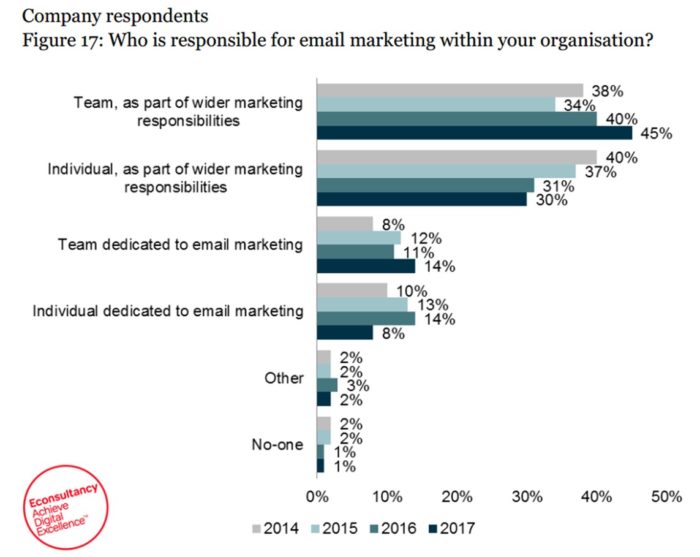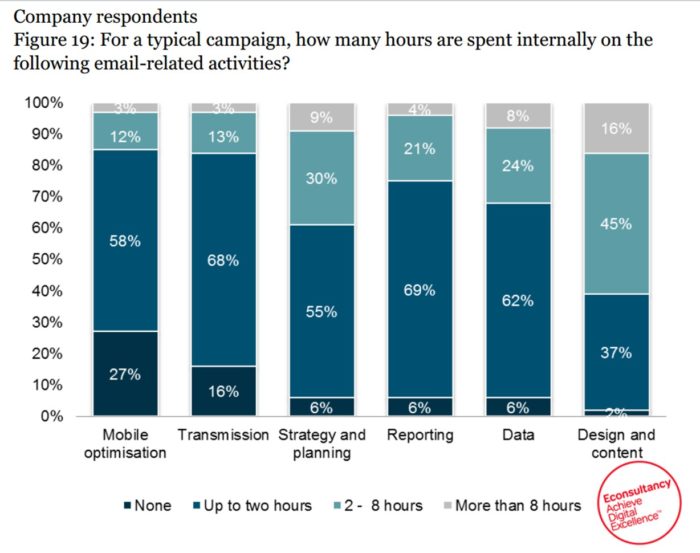Email is yet again king of ROI this year, according to the 2017 Email Industry Census. With 73% of marketers reporting ‘excellent’ or ‘good’ ROI, it’s not surprising to see investment in the channel is also growing. Despite its many predicted ‘deaths’, email has slowly become the centre of the digital marketing landscape. Referred to as a ‘unique identifier’ or ‘digital passport’, email succeeds where the cookie and ad IDs fail, bringing together data about a customer under one unified string.
The Census also showed that sales directly attributed to email are on the rise (reaching 22% in 2017), despite budgets amounts allocated to the channel being stagnant. Although with the challenges of attribution, the percentage of sales likely influenced by email is even greater, but that’s a different story for another time.
With great ROI and revenue on the rise, who’s in charge of email these days?
Simply put: it’s a team effort. The last four years have shown a consistent and considerable decline in individuals responsible for email marketing as part of wider marketing tasks – down to 30% from 40%. Rather than introducing more job specialisation, the shift has introduced email marketing to a wider pool of users. The percentage of companies who give responsibility to their team as part of their general roles has increase by 13% in the last year alone (from 40% to 45%) and by 18% in the past 4 years.
One possible explanation for this is that email marketing providers have become a lot more competitive in terms of providing easy-to-use email editors. This opens up the opportunity for marketers with little or no HTML experience to quickly put together email campaigns for their goals, allowing more people to benefit from the advantages of the channel. Another possible cause is that, as marketers focus on the customer experience across channels, email has become the focal point of this integrated approach.
However, it must be said that a boom in email editors available in the market has also highlighted more chances for errors when edits don’t go according to plan. There are two possible solutions to this: marketers must either appeal to user support channels to fix errors before campaigns go out or choose robust editors with lockable areas that don’t leave room for errors.
How are resources divided?
Looking at the time spent on email activities, the 2017 Email Industry Census has highlighted that companies spend the least amount of time on transmission and mobile optimisation, with the bulk of resources going to design and content.
A decrease in mobile optimisation is expected as more and more marketers adopt templates that are easy to customise to the purpose of the campaign, without having to code something from scratch every time. This also backs up the point made above about increased accessibility across the whole marketing team.
However, an important distinction remains to be made between the time spent on creative tasks versus strategic ones. As the chart results show, 6 in 10 marketers spend more than two hours on design and content, but less than 4 in 10 spend this amount on strategy and planning. While it’s tempting to make sure your email campaigns are engaging and visually appealing or there is pressure from management to get campaigns out the door, marketers must spend more time upfront mapping objectives and KPIs to understand and increase the impact of their messaging.
As email marketing has become more of a team responsibility, it highlights the need for an integrated approach across marketing disciplines to avoid sending too many or confusing messages to the same subscriber. This should be no problem as with technology advances such as marketing automation and easier to use email editors, marketers should have more time to focus on strategy and planning. Personalisation and automation can create multiple efficiencies while increasing relevance. But it’s up to the individual to make sure that optimisation and strategic thinking are also part of the equation to be on the road to First-Person Marketing and truly deliver customers an experience that they expect, enjoy and convert from.
For a full copy of the 2017 Email Industry Census report, visit Adestra’s website.







